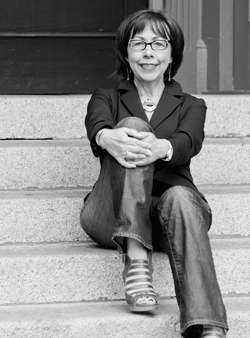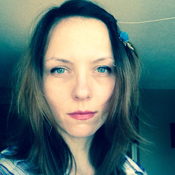Ambiguity of a Child Narrator:
Melissa Stephens in Conversation
with Wanda Hurren

Malahat volunteer Melissa Stephens talks with 2015 Open Season Fiction Award winner Wanda Hurren about her prize-winning story, "Rain Barrel." The story will appear in Issue 190, Spring 2015 of the Malahat.
Click here for the original announcement page on Wanda Hurren's Open Season Award win.
Congratulations on winning the 2015 Open Season award for Fiction! What was your initial reaction when you learned that “Rain Barrel” was selected?
Pure delight! I had actually gone online early in January to check for the Open Season announcement, and mistakenly read the list of 2014 recipients as 2015 recipients and so I assumed, with much disappointment, that the competition was over. When I first learned that “Rain Barrel” was selected I was in my office and I jumped up and down with joy!
Do you see this work as a form of flash fiction? Could you comment on the relationship between its brevity and the foreboding mood it produces?
I see the story as a form of postcard story. It is a brief glimpse into a place and a family in that place, and while the foreboding mood grows as the day/story unfolds, the reader comes upon that mood in almost a moment—my intention was to evoke that foreboding in a flash, so to speak, and then leave the reader to ‘write’ a larger story.
“Rain Barrel” is part of a larger writing project. How do you see this story in that context?
For the past several years I have been working on a collection of poems, short stories, and photographs based on the general theme of the absence/presence of water on the prairies. The collection has grown out of a more general research project I conducted some years ago that explored non-traditional ways of mapping places and people [SSHRC research grant titled, Mapwork as an Approach to Exploring Notions of Place and Identity]. I like the notion of ‘companion readings’ and I have titled the collection Bodies of Water: Companion to a Prairie Atlas. I see the collection performing the role of friend or companion to the reader, and to the more traditional atlas. It’s a collection that acts almost like a travelling companion to people who come to the reading, and one that shares the ‘behind the scenes’ stories of places and the people in those places. So in terms of ‘bodies of water,’ I am working alphabetically, and the story “Rain Barrel” falls under the Rs. One of my favourite books for both form and content is Helen Humphrey’s book of fiction The Frozen Thames. I would like to use a similar form of vignettes mixed with historical and geographical facts and photographs of prairie bodies of water.
In the beginning of this piece you define the rain barrel in past tense and in relation to its uses for survival and death in the prairies. What inspired you to take this approach?
I constructed this story based on information about social, geographical and historical conditions on the prairies during the 1930s, thus the past tense in the definition. Overall, water is a factor that figures largely in survival and death on the prairies, and I have been using bodies of water as starting points for stories.
The narrator identifies “a string of signs” for what is to come. The “small circle of light” inside the family home is referred to as “the last sign.” The use of light here made me think about your work on contemplative photography, mapping, well-being, and aesthetic sensibility. Can you comment on this possible connection and tell us in what ways your other projects may influence this piece of creative writing?
I love this question! I think that much of my writing is first conceived visually. As someone who practices contemplative photography, I am often intrigued by small everyday things that I see and I guess I remember those moments of seeing, and call them up as catalysts for story telling. I often focus on a small detail, and work from there. Having lived for some time in a small prairie town and also on a farm, the isolation of that was often catalyst for creativity. And car lights were exciting—they often signalled someone coming to visit or someone driving on the highway nearby. A few years ago I held a research grant that allowed me to inquire into non-traditional ways of mapping places and people, and photography and poetry and short stories were included as ‘mapwork’. I see “Rain Barrel” as a form of ‘mapwork’—constructing notions of a place through story.
This story could be about postpartum depression, psychological instability, attempted murder, or a range of other issues. The uncertainty that lingers seems linked to the limited storytelling perspective of the child who bears witness to something that cannot be named. Have you considered telling the story from other viewpoints?
I first tried to tell this story as one of postpartum depression from the viewpoint of the mother, and yet, it is also a story with strong geographical and historical determinants. In some of my earlier research I came across information related to the higher incidence of committals to psychiatric wards in prairie hospitals during the dry decade of the 1930s, and that is the time period I worked with for “Rain Barrel.” I chose the young boy because there are so many possible issues informing this story, and telling it through his eyes allowed me to include hints of all those issues and maintain a level of ambiguity that wouldn’t be acceptable if an adult was the narrator.
You work academically in the area of Curriculum Studies at the University of Victoria. Can you comment on the relationship between your academic and creative processes? Are there ever conflicts of interest, in terms of time, labour, methodology, or do you find that you’re able to find meaningful connections?
I do find meaningful connections, in that I allow my creative spirit to have a space within my academic work. For example, the title of my doctoral dissertation was Line dancing: An atlas of geography curriculum and poetic possibilities, and I begin every class I teach by reading a poem. I often assign photo essays, and we conduct ‘mapwork’ in courses focused on social studies education and community and culture. My research has always included an attention to aesthetics, whether through photographic ‘data’ or poetic language. However, the academy doesn’t always consider those connections meaningful in terms of tenure and promotion.
Can you tell us of any current creative projects underway?
As well as working on the collection Bodies of Water: Companion to a Prairie Atlas, I am also working on a contemplative photography research project with Scotiabank that explores how paying attention to aesthetics in the workplace might enhance well-being (and thus creativity and productivity) in the workplace. And I am working with a group of photographers to plan an exhibition of coffee prints—we are developing some of our prints in coffee rather than traditional chemical developer.

Melissa Stephens
* * * * * * * *









